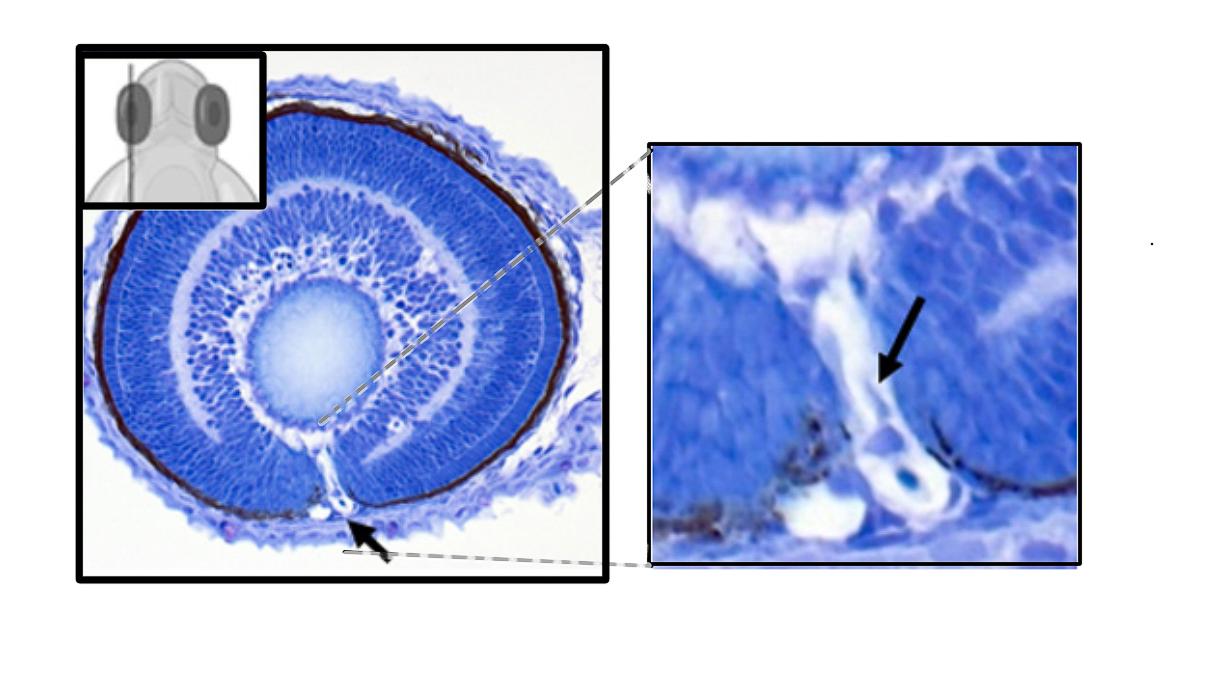Scientists at the National Eye Institute (NEI) have developed a zebrafish model of NEDBEH—a rare genetic disorder that can cause coloboma, where parts of the eye are missing due to developmental defects. The model provides a new tool for understanding the eye's embryonic development. The NEI is part of the National Institutes of Health.
"Despite advances in genetics, the underlying cause of coloboma in most families remains unclear," said Brian Brooks, M.D., Ph.D., chief of the NEI Ophthalmic Genetics and Visual Function Branch. The ongoing mystery is partly due to the myriad genes that must be turned on and off at pivotal moments for the eye's normal development.

Uveal coloboma refers to missing parts of the uveal tract—the middle layer of eye tissue that includes the iris, the ciliary body, and the blood vessel-rich choroid. Marked is the approximate location of the optic fissure, which normally closes during embryonic development. Failure of the fissure to close anywhere along this line results in a coloboma. A coloboma's impact on vision varies according to its location and severity. It can cause anything from slight blurriness to blindness. Credit: National Eye Institute.
Brooks and George characterized early eye development in zebrafish with a mutation in the gene rerea—the zebrafish equivalent of the human RERE gene. Compared with normal zebrafish, mutants showed eye defects including enlarged optic stalks, eye tissue in the brain, and coloboma. The optic stalk is a transient eye structure that connects the eye to the brain.

Cross section of an embryonic rerea mutant zebrafish eye showing coloboma. In normal zebrafish, the optic fissure closes. Credit: Brian Brooks, National Eye Institute.
The rerea mutation altered the expression of key developmental genes. Of note, the rerea mutation interfered with signaling of sonic hedgehog (shh), an important protein that directs the development of a variety of organs and tissue, including the optic stalk and retina. By inhibiting the shh pathway at a different point, the scientists rescued coloboma, leading to proper closure of the optic fissure.

Brian Brooks, M.D., Ph.D. (left) and Aman George, Ph.D., NEI Ophthalmic Genetics & Visual Function Branch. Credit: National Eye Institute.
“Our zebrafish model helps clarify the role of the RERE gene in eye development,” said George. “Identifying appropriate model systems for studying coloboma is essential to understanding its underlying mechanisms and finding targets for rescuing defects."
For more information about coloboma, visit the NEI website.
Reference:
George, A., Lee, J., Liu, J., Kim, S. and Brooks, B.P. (2022), Zebrafish model of RERE syndrome recapitulates key ophthalmic defects that are rescued by small molecule inhibitor of shh signaling. Developmental Dynamics. Accepted Author Manuscript. https://doi.org/10.1002/dvdy.561
This press release describes a basic research finding. Basic research increases our understanding of human behavior and biology, which is foundational to advancing new and better ways to prevent, diagnose, and treat disease. Science is an unpredictable and incremental process— each research advance builds on past discoveries, often in unexpected ways. Most clinical advances would not be possible without the knowledge of fundamental basic research. To learn more about basic research, visit https://www.nih.gov/news-events/basic-research-digital-media-kit.
NEI leads the federal government’s efforts to eliminate vision loss and improve quality of life through vision research…driving innovation, fostering collaboration, expanding the vision workforce, and educating the public and key stakeholders. NEI supports basic and clinical science programs to develop sight-saving treatments and to broaden opportunities for people with vision impairment. For more information, visit https://www.nei.nih.gov.
About the National Institutes of Health (NIH): NIH, the nation’s medical research agency, includes 27 Institutes and Centers and is a component of the U.S. Department of Health and Human Services. NIH is the primary federal agency conducting and supporting basic, clinical, and translational medical research, and is investigating the causes, treatments, and cures for both common and rare diseases. For more information about NIH and its programs, visit https://www.nih.gov/.
NIH…Turning Discovery Into Health®